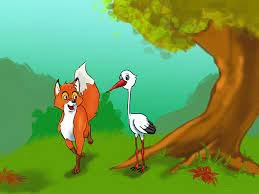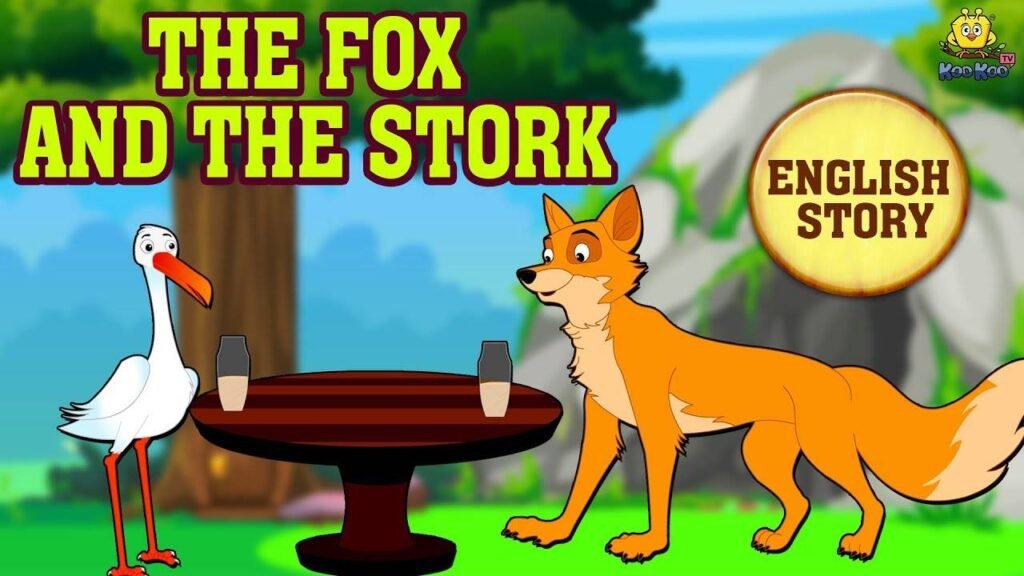The fable of The Fox and the Stork presents one of Aesop’s most sophisticated lessons about reciprocity and poetic justice, wrapped in a deceptively simple story of two animals sharing meals. While commonly dated to 6th century BCE Greece, versions of this “trickster tricked” narrative appear across global folklore – from West African tales featuring a spider and bird to Native American stories pairing coyote with crane. The classic version begins with a self-satisfied fox inviting the stork to dinner, serving soup in a shallow dish that only he can lap up while the stork’s long beak leaves her hungry. When the stork returns the invitation, she serves minced meat in a narrow-necked vessel, giving the fox his comeuppance as he stares helplessly at the unreachable meal.
What most modern retellings omit is the original Greek context – this was likely a satire about Athenian host-guest customs (xenia), where violating hospitality norms carried serious social consequences. The specific choice of animals holds symbolic weight: foxes represented cunning without wisdom in Greek lore, while storks symbolized parental duty and justice (from their Greek name “pelargos” meaning “bringer of order”). The contrasting tableware – broad dish versus slender jug – mirrors the philosophical concept of “appropriate measures” that Aristotle would later explore in his Nicomachean Ethics.
Historical analysis reveals how different cultures adapted the fable. Roman versions made the stork a heron and emphasized legalistic revenge fitting the crime. Medieval bestiaries transformed the animals into Christian symbols – the fox became false preachers offering empty spiritual nourishment, while the stork represented righteous judgment. The story’s most fascinating adaptation emerged in colonial America, where Puritan settlers recast it as a warning about false charity, with the fox as wealthy landowners and the stork as indentured servants.
Modern psychologists recognize the fable as an early exploration of “theory of mind” – the fox’s failure to consider the stork’s physical difference mirrors how children under age seven struggle with perspective-taking. The meal settings themselves carry cultural significance – in original Greek tellings, the fox uses a “pinax” (sacrificial dish), violating its religious purpose, while the stork’s vessel resembles an “aryballos” (perfume flask), repurposing elegance as justice.

The characters embody universal archetypes with surprising depth. The fox represents more than mere trickery – he embodies performative generosity, a social manipulator who gives only to flaunt superiority. His shallow dish choice reveals what psychologists now call “instrumental hostility” – aggression disguised as goodwill. The stork, often mischaracterized as merely retaliatory, actually demonstrates sophisticated social intelligence by responding in kind rather than with violence – what conflict resolution experts term “mirror principle” justice. Even the absent “audience” of other forest animals plays a role in original versions, observing and judging the interactions like a Greek chorus. The story’s minimalist dialogue (often just two exchanges) makes its impact more potent – the stork’s quiet reversal speaks louder than any moralizing epilogue.
Scientific insights validate the fable’s core premise. Behavioral ecologists note that real foxes do cache food selfishly while storks share communal nests, grounding the allegory in natural observation. Cognitive studies show that experiencing unfairness activates the same brain regions as physical pain, explaining why the stork’s retaliation feels viscerally satisfying. The story even anticipates modern game theory’s “tit-for-tat” strategy – the most effective response to defection is measured reciprocation, exactly as the stork demonstrates. Anthropologists have found similar reciprocity norms in every culture studied, from Japanese “giri” (social obligation) to Maori “utu” (balanced exchange), proving the tale’s universal resonance.
Modern applications abound. Teachers use it to discuss bullying consequences, diplomats cite it in negotiations about mutual concessions, and HR professionals reference it when creating inclusive workplace policies. The food vessels have become metaphors in design theory – user experience specialists call the fox’s dish “exclusionary design” while praising the stork’s jug as “adaptive solutions.” Silicon Valley has co-opted the parable, with “fox founders” who build for their own needs versus “stork founders” who consider diverse users. Even children intuitively grasp its lesson – studies show kids as young as five will reject unequal reward distributions, echoing the stork’s sense of fairness.
What makes The Fox and the Stork endure is its elegant balance of poetic justice and psychological truth. Unlike fables where villains suffer externally, here the fox’s punishment is simply experiencing what he inflicted – a mirror held up to his own behavior. In an era of performative altruism and transactional relationships, this ancient tale reminds us that true hospitality considers others’ needs, and that fairness isn’t about equal treatment but equitable accommodation. From ancient symposiums to modern boardrooms, its message remains vital: the measure of any society lies not in how it treats the powerful, but in how it adapts for the different.
Go to main page


